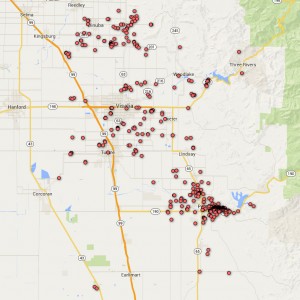Unseasonably warm temperatures with a ridge of high pressure holding any potential weather systems from entering California have only added to the drought situation, especially for the Valley. And the chance of any sizeable amount of rainfall in the immediate future is bleak.

“It’s looking grim, at least for the next 7 or 10 days,” said Kevin Durfee, meteorologist with the US National Weather Service in Hanford.
“And, the snow pack is really pretty pathetic,” he said.
The local Southern Sierra snowpack is at 24% of normal, he said, which is actually better than last year at this time, when it was 12%.
Even though March can be a wet month, it would be difficult at this stage to get caught up, Durfee added.
“We would need 20 inches of snow in the mountains,” he said.
California is entering its fourth consecutive year of drought, with the most severe impact hitting Tulare County, said Andrew Lockman, Tulare County Office of Emergency Services manager. Within the county, the area to the east of Porterville is most effected.
Many wells there are only 25- to 60-feet deep. Some property owners have had intermittent problems in the past, but the recent drought has turned off the tap on 938 private wells for property owners.
That is 55% of reported private well-problems in the state, Lockman said.
Reports of non-working wells continue to come in to the Emergency Services office; however, it is probable that more are just being reported than are now running dry, he said.
Last summer saw neighbors aiding one another with garden hoses to wells that were operational offered to those who did not have water. However, a constant fear of another well going dry is a major worry in the area.
The county has aided the area with portable showers in the neighborhood, the bottle water program wherein every two weeks residents receive fresh drinking water, and most recently a tank program, where residents receive the use of a 1,500-2,000-gallon tank, refilled on a regular basis with potable water. These are all temporary solutions.
“We’re kind of slapping Band-Aids on this thing,” Lockman said.
Long-term solutions continue to be discussed. Of course, for those who can afford it, the easiest solution is to dig deeper wells. However, many in the area are renters, and landlords may or may not be willing to invest that cost into the property, basically evicting renters who cannot afford to move elsewhere.
Some are looking to tap into the water system of the nearby city of Porterville. But while the Porterville City Council continues discussion on that idea, most recently at its February 5 meeting, this would be a major undertaking, Lockman said.
It would take at least five years, at the cost of an estimated $25 to $30 million, he said.
“It is not the City of Porterville’s responsibility,” he said, adding that the city should look after its own first.
And while it may be willing to consider tapping into the water system for those out in the county, outside city limits, “where does the $30 million come from?” he questioned.
The infrastructure and physical work may only take a year, but finding the funds, planning, engineering studies and prep work could take four years or longer.
One example that has worked is the unincorporated area of Cameron Creek Colony just outside Farmersville. Some wells have also gone dry there.
Residents with intermittent well problems began speaking about it a couple of years ago and by June, 2014 told county officials they had a problem. Because they had been talking about it and researching potential solutions, they found their solutions quickly, Lockman said.
Within weeks, the Cameron Creek residents received $1 million in grant money, half of which was granted from the State Water Resources Control Board, drinking water division, and half of which came from USDA Rural Development. The money has been spent on engineering, planning and now the fruition of the pipeline from Farmersville to the community. Residents now have the opportunity to hook-up to the city water-service. Water service should be available to those who sign up by next month.
The unincorporated residents of Monson, east of Dinuba, are not so lucky. While they have expressed concern and many wells have gone dry, they did not have the organization or commitment to move forward, Lockman said. If they can pull together and work together, they may be able to find a similar solution, but it will take time.
As the drought continues, the problems are worsening.
“Absolutely yes, unfortunately, it is getting worse,” Lockman said.
“We are starting with a much larger deficit (of water) than last year,” he said, “and we are the most impacted part of the state, that I have heard of.”
There is a chance of some relief in the weeks to come, Durfee offered. The long-range report, which indicates weather predictions for 60 to 90 days, offers a 33% chance of better than average rainfall. But, whether that will come to fruition is still yet to come.
